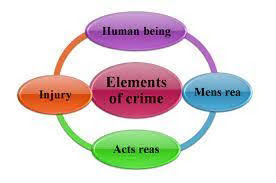Introduction:
In criminal law, the commission of a crime typically involves several key elements. The main constituent elements of crime are: human being, actus reus (guilty act or the criminal act), mens rea (guilty mind or the criminal intent), injury, and punishment.
Each of these elements plays a critical role in defining and prosecuting crimes.
These elements must be present for an act to be considered a crime.
For an act to be considered a crime, it must be committed by a human being. Legal systems typically hold individuals accountable for their actions, and the laws governing crimes apply to human actors. The concept of personhood is central to criminal liability; non-human entities such as animals or inanimate objects cannot be held criminally responsible. In modern legal contexts, this can extend to corporations and organizations, but these are still treated as juridical persons represented by human actors.
2. Actus Reus (Guilty Act or the criminal act):
Actus reus refers to the physical act or unlawful omission that constitutes a crime. This element focuses on the objective component of a crime, which can include actions like theft, assault, or even failing to act when there is a legal duty to do so (e.g., a parent failing to provide necessary care for their child). For a crime to be established, there must be a clear demonstration that the defendant engaged in some form of prohibited conduct. Mere thoughts or intentions are not enough; there must be an observable action or inaction that violates the law.
3. Mens Rea (Guilty Mind or the criminal Act):
Mens rea refers to the mental state or intent of the person committing the act. It is a crucial element in distinguishing between different types of crimes and determining the severity of the offense. Mens rea can range from intentional acts (e.g., premeditated murder) to reckless or negligent behavior (e.g., involuntary manslaughter). The law typically requires that the defendant had some level of awareness or intent regarding their actions to establish criminal liability. This element ensures that individuals are not unjustly punished for accidents or mistakes that lack a culpable state of mind.
4. Injury:
Injury or harm refers to the impact of the criminal act on the victim or society. This can be physical, emotional, or financial harm, and it is a necessary element for certain crimes. For example, in cases of assault, the injury might be bodily harm, while in fraud cases, the injury would be financial loss. The degree of injury often influences the severity of the charges and the corresponding penalties. However, some crimes, such as attempts or conspiracies, may not require actual injury but focus on the potential for harm.
5. Punishment:
This element signifies that the act must be punishable under the law. There must be a statutory provision that prescribes a penalty for the act or omission, reflecting society's condemnation and legal consequences for the behavior.
Punishment is the legal consequence imposed on individuals found guilty of committing a crime. It serves several purposes, including retribution, deterrence, rehabilitation, and incapacitation. The type and severity of punishment depend on the nature of the crime and the applicable legal statutes. Common forms of punishment include fines, imprisonment, community service, probation, and, in some jurisdictions, capital punishment. The goal is to ensure that justice is served by holding the offender accountable and preventing future crimes.
Integration of Elements for Criminal Prosecution & Punishment:
For a complete and effective prosecution, all these elements must be proven beyond a reasonable doubt. The absence of any one element can lead to the failure of the prosecution's case. For example, if there is no mens rea, a defendant might be acquitted of a crime on the basis of lack of intent, even if the actus reus is evident.
Examples and Case Law:
Consider the crime of theft. The actus reus is the unlawful taking of someone else's property. The mens rea is the intent to permanently deprive the owner of that property. If a person takes another's property believing it to be theirs, the mens rea element may be missing, potentially leading to an acquittal.
In contrast, strict liability crimes, such as statutory rape, do not require proving mens rea. The mere act (actus reus) of engaging in sexual activity with a minor is enough for conviction, regardless of intent or knowledge.
Conclusion:
The constituent elements of crime—human being, actus reus, mens rea, injury, and punishment—form the foundation of criminal law. They ensure that justice is administered fairly by requiring a comprehensive demonstration of both the act and intent, as well as the impact of the crime. .




No comments:
Post a Comment